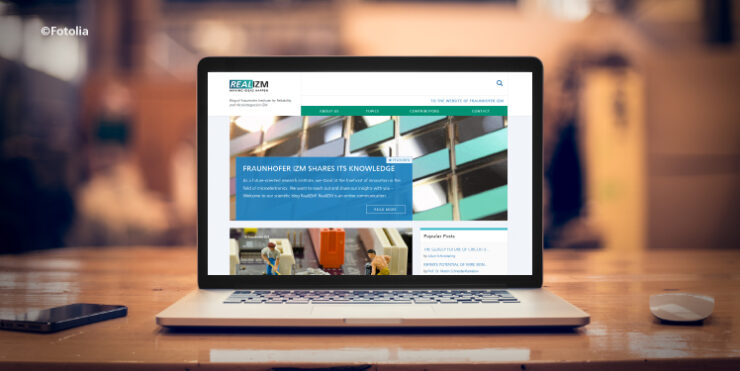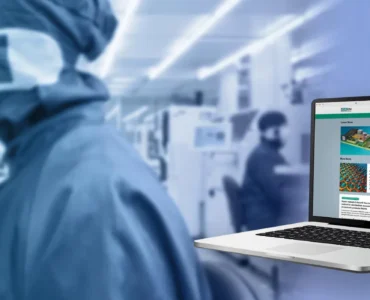From systems for charging body implants, electronic textiles, and computer systems in your ear to the glass circuit boards of the future and new types of wafer level packaging.
This article is dedicated to our RealIZM blog. We are celebrating its second birthday and want to share the top-ten articles from these two years with you. But we don’t only want to talk about the interesting topics we contributed with IZM’s experts, but also celebrate you, our readers. You brought these topics into the top-ten by picking them and showing your interest in the knowledge our researchers had to share. Our goal here is to give you easy access to research, application-oriented topics, and information about disruptive technologies in a different manner than a scientific paper would. It is great to see that you enjoy reading what we put out there.
These articles are among the top-ten for a reason, as they definitely mirror the variety of research that is done at Fraunhofer IZM.
- To build more reliable and longer-lasting power modules, Fraunhofer IZM wants to develop new material compositions for heavy wire interconnections. Professor Martin Schneider-Ramelow, acting director of Fraunhofer IZM, spoke to RealIZM about the “AICuBo” project (AI Cu bonding wires for power electronic modules). The project is all about developing processes for scaling up the production of AlCu composite wires for power electronics to get them ready for mass production by extrusion and wire drawing, and characterising the resulting mechanical and electrical properties. This shows that progress in wire bonding is far from slowing down. You can find more information about this project in this article: INFINITE POTENTIAL OF WIRE BONDING: NEW RESEARCH FINDINGS | RealIZM (fraunhofer.de)
- Fraunhofer IZM was a partner on the Moore4Medical project, which brought together 66 companies, universities, and research institutes from more than ten countries. The IZM researchers Andrada Velea and Dr Vasiliki Giagka worked on means to power implants wirelessly via ultrasound and explored ways to stimulate tissue by using ultrasound for neuromodulation. You’ll find more information about how they pursued these goals in this article: A REVOLUTION FOR NEURAL IMPLANTS: WIRELESS CHARGING AND NERVE STIMULATION | RealIZM (fraunhofer.de)
- Modularity might become more important for electronics like smartphones. Consumers want their products to live longer, not least with sustainability in mind. The modules making up a modular product are, by definition, structurally independent elements. Read more about this interesting topic regarding the future of electronic products in this article contributed by Marina Proske: MODULAR ELECTRONICS – A SUSTAINABLE SOLUTION FOR THE SMARTPHONE ERA? | RealIZM (fraunhofer.de)
- Fraunhofer IZM not only does its own research, but also shares its knowledge and technical equipment with motivated entrepreneurs who want to start their own company. through the Start-a-Factory programme, Mike Richardson got the chance to work together with experts from Fraunhofer IZM for his start-up Photonic Insights to develop prototypes and have the opportunity to test them. You can read what Photonic Insights does here: PHOTONIC INSIGHTS – ENLIGHTENING THE MATERIAL WORLD | RealIZM (fraunhofer.de)
- Julian Schwietering’s research is focused on electro-optical circuit boards, which use both optical and electrical layers. Fraunhofer IZM’s approach is unique in that it is using low-cost commercial thin glass in large sizes of up to 440 mm x 330 mm as the basis for these circuit boards. The resulting boards have optical waveguides inside the glass, sandwiched between two surfaces with electrical circuits. Is glass the future of circuit boards? Julian Schwietering believes so, as conventional electrical circuit boards are pushed to their limits by the large amounts of data that need to be transmitted nowadays. Going forward, optical signals will be necessary. To understand more about glass circuit boards, read the full interview here: THE GLASSY FUTURE OF CIRCUIT BOARDS | RealIZM (fraunhofer.de)
- Stefan Hoffmann at Fraunhofer IZM is working on new designs for passive and magnetic components to improve the design of inverter systems. Power electronics play an important role in driving the energy revolution. With the special test chamber at Fraunhofer IZM capable of accurately measuring switching losses, Stefan and his team have the means to tackle a tough challenge: miniaturizing power electronics. Every component corelates in some way to all others, which has to be considered. To find out more about what kind of products we are talking and what the future holds for power electronics, read our full article: POWER ELECTRONICS – CONVERTING CURRENTS THE MODERN WAY | RealIZM (fraunhofer.de)
- Smart textiles or rather e-textiles, as Malte von Krshiwoblozki, researcher at Fraunhofer IZM, prefers to call them, are attracting more and more interest. They offer new prospects for protection, fashion, and communication, but there are still some engineering obstacles to overcome. The electronics embedded in the textiles have to be flexible, water and dirt-resistant, and very small. The System-on-Flex group at Fraunhofer IZM is developing different kinds of e-textiles. Want to know whether our clothes are going to communicate with us at some point? Find out in our interview with Malte von Krshiwoblozki: HOW WEARABLES WILL AFFECT PROTECTION, FASHION, AND COMMUNICATION | RealIZM (fraunhofer.de)
- Another start-up coming from the Start-A-Factory environment is Hearable Labs. Pauline O’Callaghan, the CEO of Hearable Labs, tells us about her vision. Hearables are tiny computers in your ear. They help you get through your day easier: You can turn the volume up or down, cut out noises you don’t want to hear, or get translations into your language served to you directly. They are supposed to reduce the use of smartphones, enabling users to really see their surrounding by removing the need to look at their phones all the time. As Pauline puts it: “They keep us in the real world with our heads up and hands free”. You can read about the future of Hearable Labs and their products’ technology in this article: THE FUTURE OF TECHNOLOGY IN YOUR EAR – ‘HEARABLE LABS’ | RealIZM (fraunhofer.de)
- Mathilde Billaud is a research fellow in the Environmental and Reliability Engineering department. She works on cost and environmental models for optimizing packaging processes. Her research is helping the microelectronics industry face current challenges surrounding sustainability, like material scarcity, ways to extend products’ lifespans, and much more. One aim of her work at Fraunhofer IZM is also to make process engineers realize that they have the ability to improve technology and their approaches towards sustainability. You can find out how Mathilde Billaud and her fellow researchers are pursuing this goal here: THE ADVANTAGES OF COST MODELLING IN PACKAGING PROCESSES | RealIZM (fraunhofer.de)
- With the digital revolution going full steam, more custom systems are needed in order to run the increasing number of end products. System integration technologies need to evolve in terms of their technology and processes in order to increase productivity and keep costs low. Another important factor is miniaturization. Today’s tiny, but powerful electronics were essentially made possible by specific types of wafer level packaging (WLP). Which specific types are needed and how they support digitalization is explained in this article: HOW PANEL AND WAFER-LEVEL PACKAGING BOOSTS SYSTEM INTEGRATION FOR DIGITAL NETWORKING | RealIZM (fraunhofer.de)
These top-ten articles show the diversity of researchers and research topics going on at Fraunhofer IZM. But there will be many more incredible interesting projects in the future, so keep following us for many more articles that will come your way.





Add comment